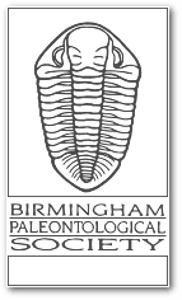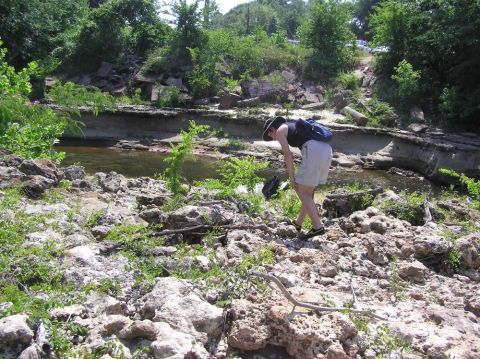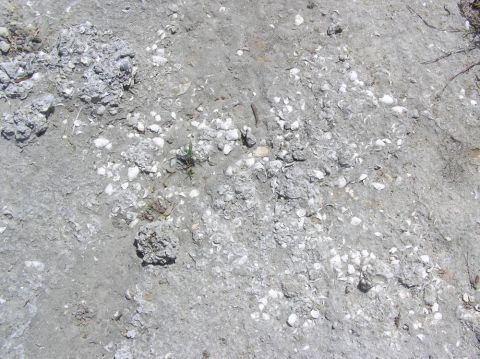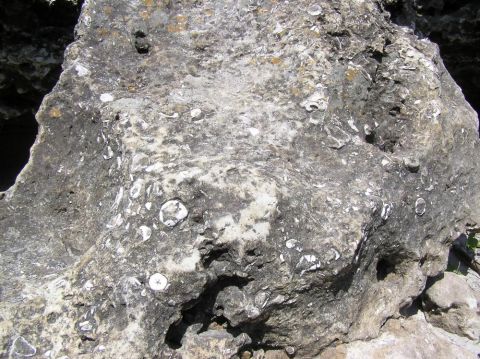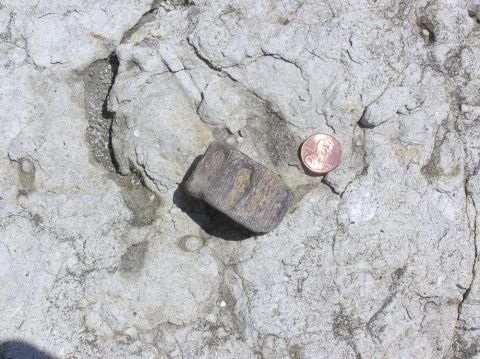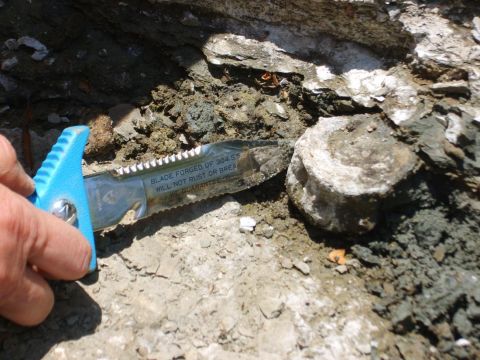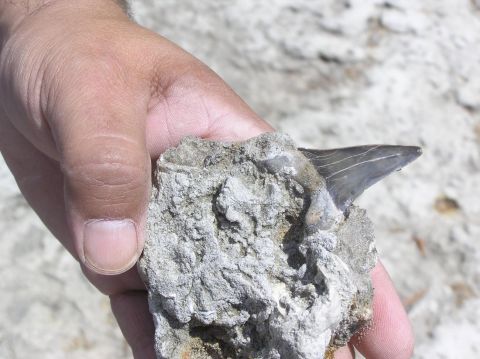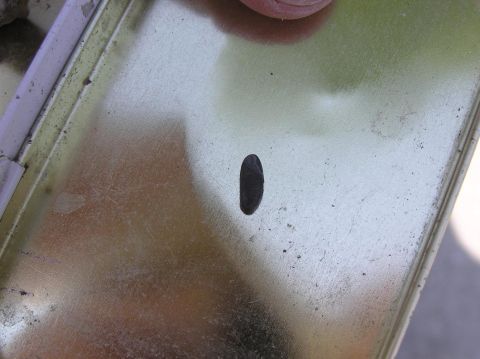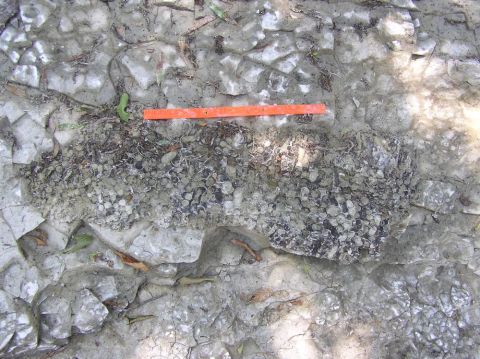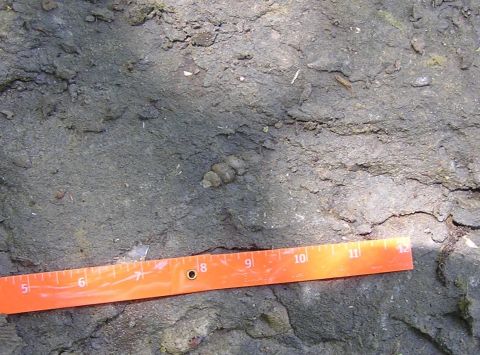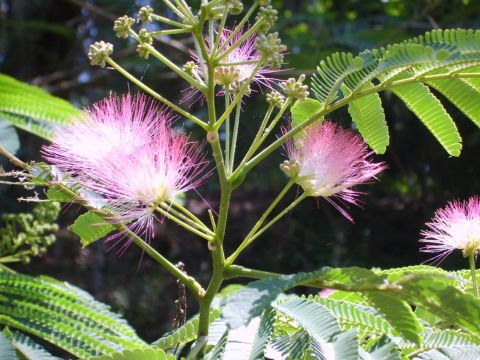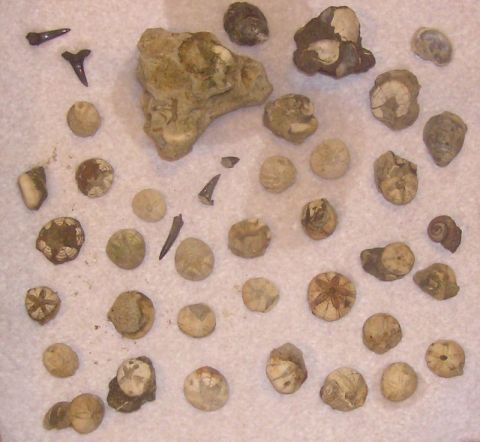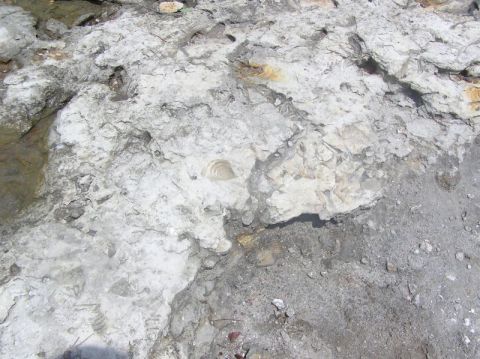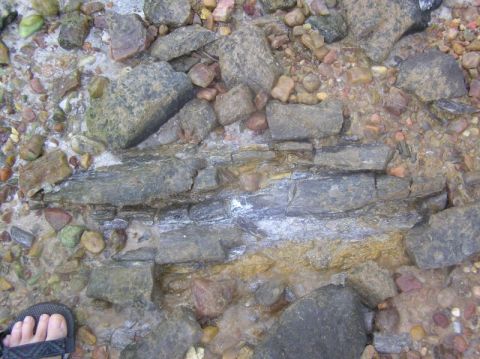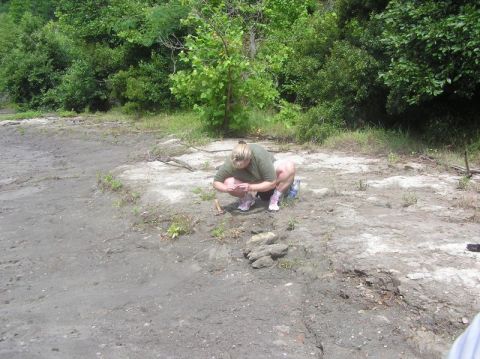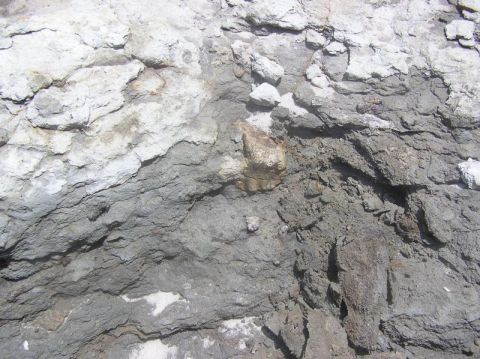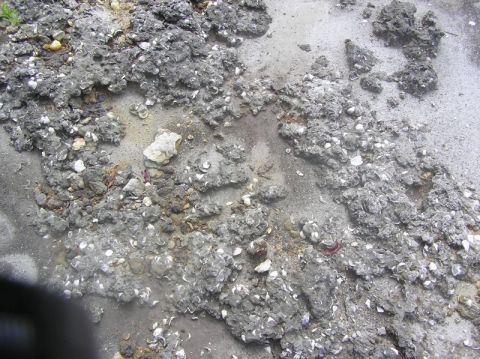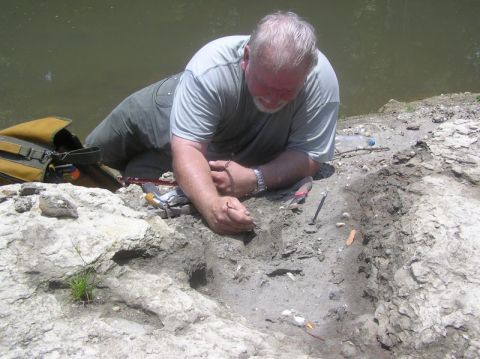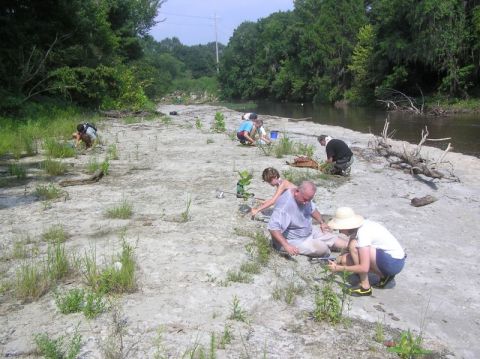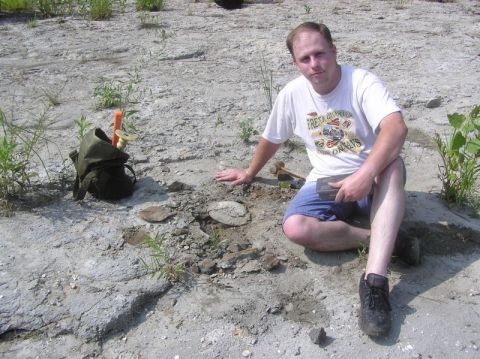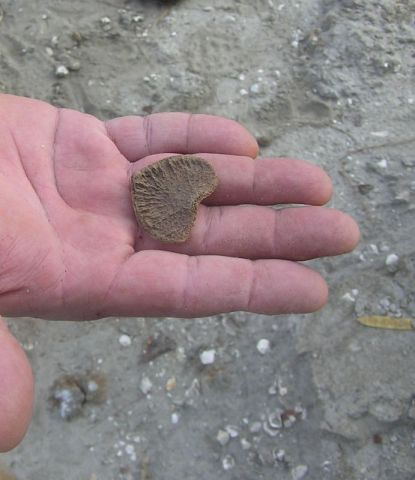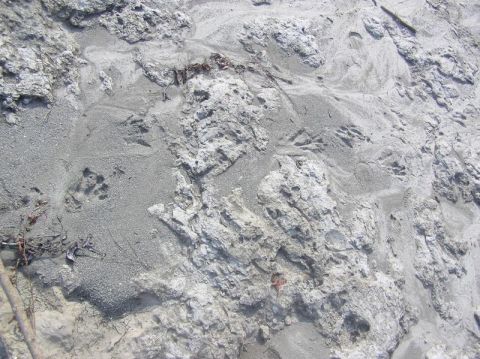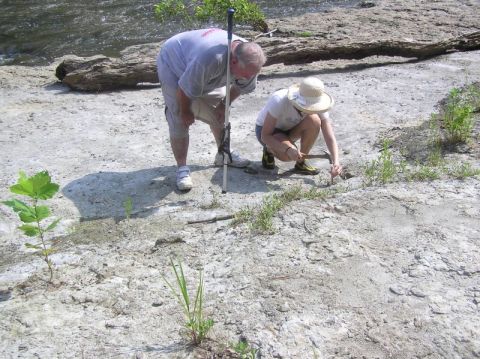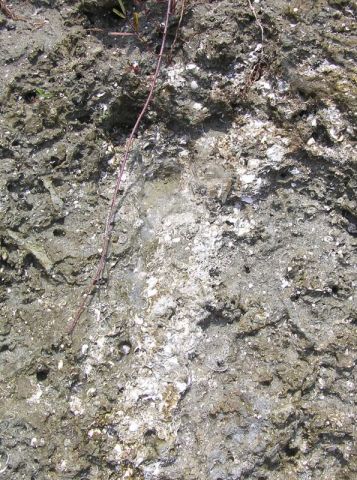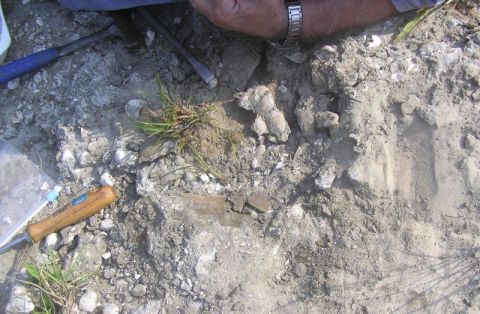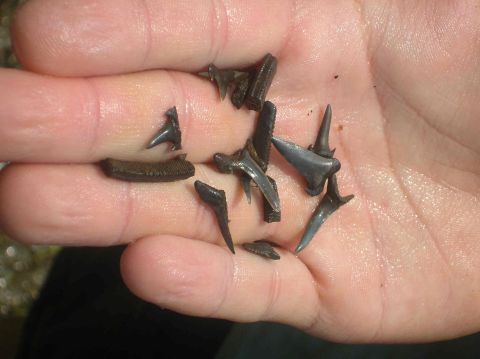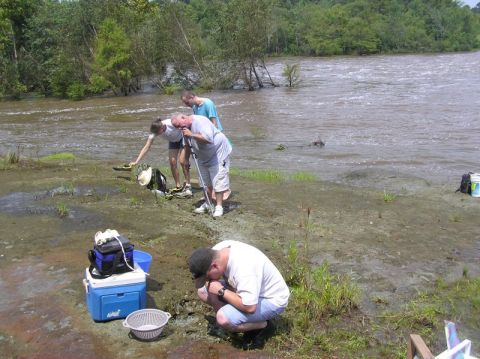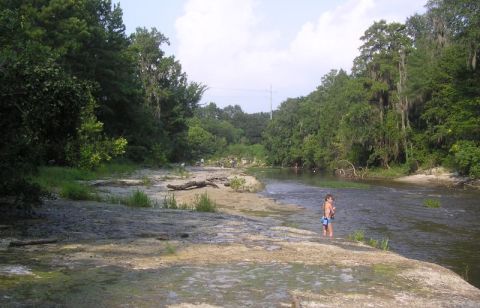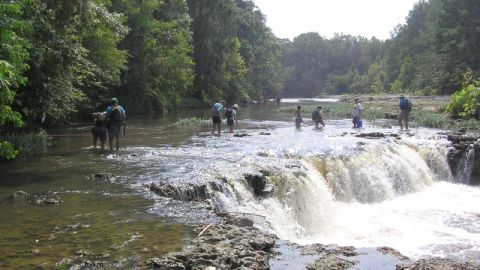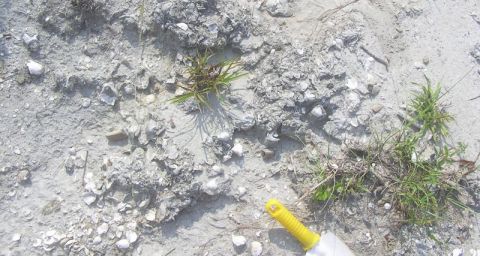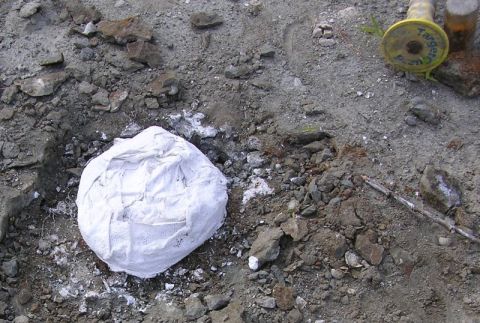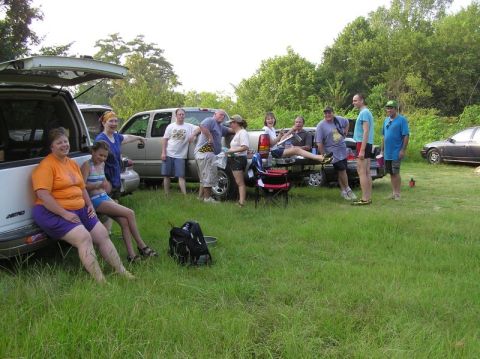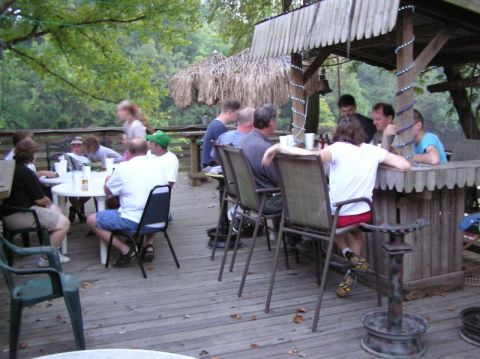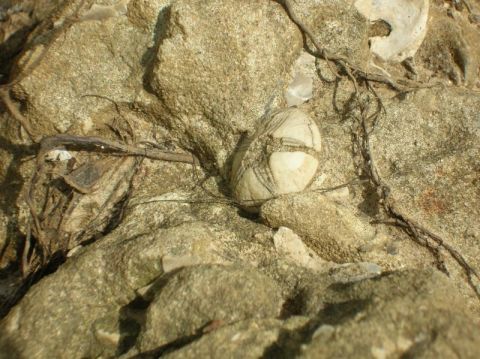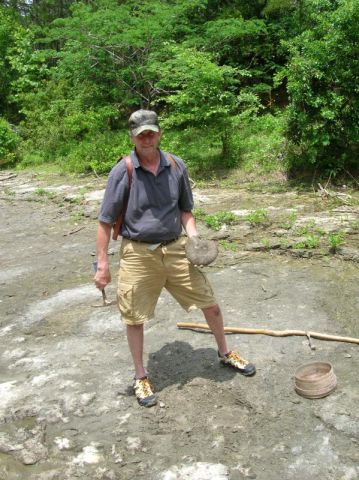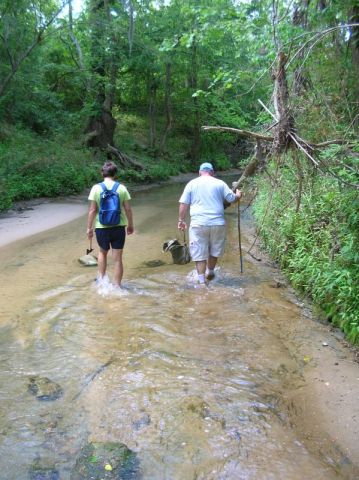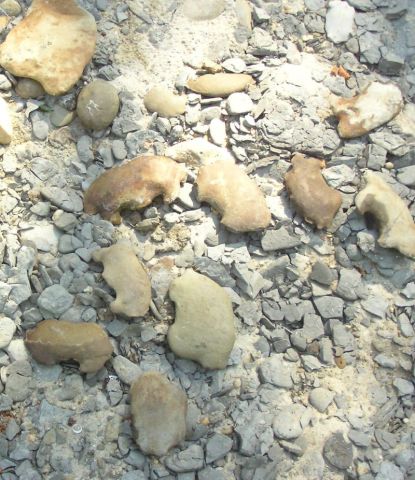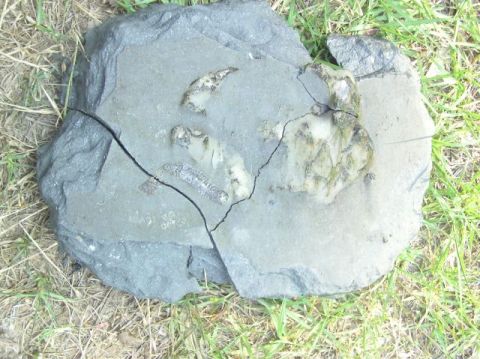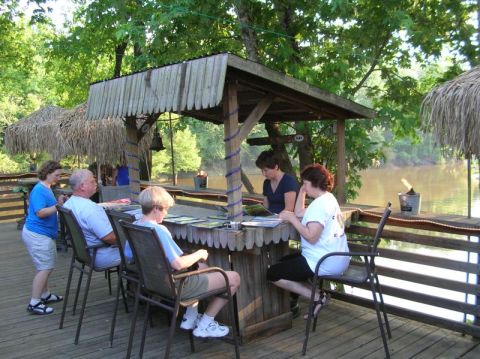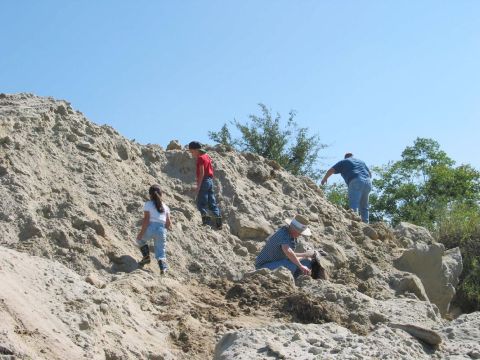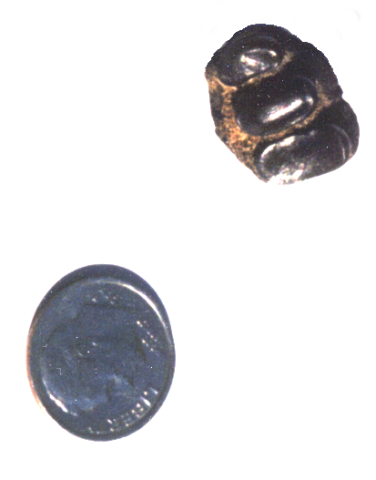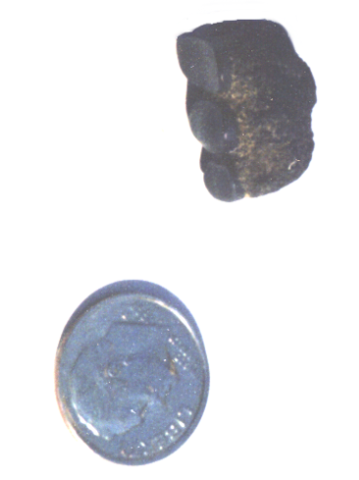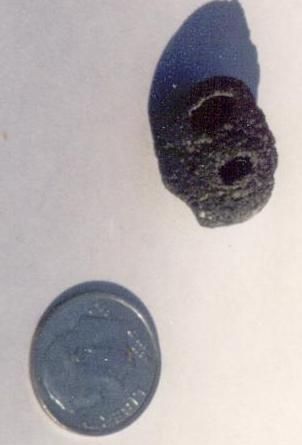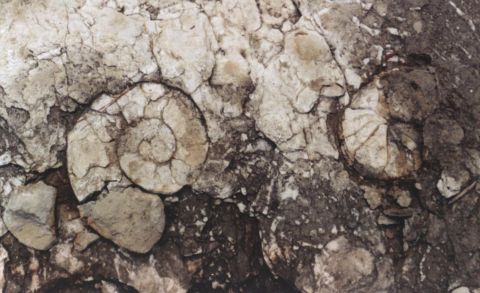Some nice echinoids.
Visitor
Montgomery
May 19, 2007 - Cretaceous Fossils, Montgomery Co, AL
Large Cretoxyrhina mantelli (Ginsu shark) tooth
Small pycnodont fish tooth - Genus Anomoeodus.
Small pycnodont fish tooth - Genus Anomoeodus.
- ‹ previous
- 17 of 17
June 24, 2006 - Cretaceous Fossils, Montgomery and Elmore Co, AL
A relatively small group of BPS members went to a creek in Montgomery County for today's trip - could it be some people were scared off by the thoughts of 95 degree weather in the sweltering sun? To get an idea of our weather, go to your bathroom, turn the shower on the hottest it will go, close the door so steam can build up, turn off the A/C, then take your laptop in there and view our trip photos - you will have a good idea of our day! Leisa brought her canoe, and she and Claire floated/pushed/dragged it upstream and then back down. This late Cretaceous site once again yielded numerous echinoids and ammonites, though most of the ammonites could only be "collected" via photos, due to their fragile composition. We also found huge quantities of shells, a few shark teeth, a couple of mosasaur vertebra, two large vertebra, possibly shark, and pyritized coprolites.
Several people decided to call it a day after getting too hot for comfort. After a refreshing afternoon lunch in an air conditioned restaurant, the die-hards brains began coming up with another potential collecting site in Elmore county. Since we have a canoe, lets go look for petrified wood. Now understand, we had one canoe, one paddle, 3 life jackets and 4 people to go on this escapade. After a quick stop at the local discount store for an additional paddle and PDF, we scouted access points. The put-in we decided on was steep. Really steep. Really really steep. But we finally got it down the several hundred feet to the water, only to find a boat wasn't necessary, the water was low, the shore was easily walkable, and petrified wood was everywhere. So we collected it (ask Jan how much his pack weighed!), took some pictures of a tree that was about 4 feet in diameter, and noticed it was getting darker. And windy. And there was thunder. And lightning. And lots of cold rain (boy, did it feel good!) And we had the canoe at the bottom of a huge hill. But Leisa, resourceful as ever, had a plan; just hook the boat to her van, and pull it out.
(photos courtesy Vicki Lais)
Wow, looks like we may have to come back to get this one, it won't fit in the canoe . . . .
Some echinoids and shark teeth from Vicki's bag. About 2pm, we were so hot, we needed a break from the heat, so a small group met at a nearby restaurant to cool our brains. And we decided to go check out a river site since we had the canoe.
Look carefully and you can see several shell impressions in this rock, along with some shells scattered in the dirt.
I knew it, I knew it, I knew it, look what they've gotten me into now! Just getting started up the steep bank. Worn out from the distance already covered, and soaking wet from the recent rain shower. But it was fun, and we had our adventure for the day!
Shells and echinoids in matrix. These rocks are pretty hard, so these were left in place.
Melanie found a nice gastropod in the same area where the tiny shark teeth were found.
Tree trunk breaking into pieces on the bank. Numerous pieces like this were scattered everywhere.
First we need the canoe way down the bluff to the river bank so we can paddle downstream. Well, now wait a minute. This river has always been much higher, all the way into the weeds, and you couldn't walk here, summer nor winter. What's going on here? We don't need the canoe after all!
Leisa very quickly found a nice vertebra. After collecting the vertebra, Leisa and Claire headed up the creek, and we didn't see them again for several hours.
Claire has found a couple of shark teeth, one still embedded in the rock matrix.
Not sure what this is, shaped like an ear bone, but looks like pottery, very smooth and obviously supposed to be shaped this way, not very worn looking.
Claire also found a pile of sh#!, um, well, or rather, a bag of pyritized coprolites!
Jan is wondering just exactly how we plan to pull this off. Perhaps he made a hasty decision to come along, as the others didn't seem to be giving any thought to the difficulty of what we were proposing. The river is down an extremely steep slope.
Greg is carefully excavating a small bone. Another piece of bone was found about 1' away from this one.
- ‹ previous
- 17 of 17
August 20, 2005 - Eocene Fossils, Covington and Cretaceous Fossils, Montgomery Co, AL
Once again, the group ended the day with a fine opportunity to hang out together at The Swamp, a kinda - sorta local eatery (only 20 minutes away, huh, Greg?) where we stayed way too long, but enjoyed the time spent with fellow fossil hounds.
(Pictures courtesy Jan Novak and Vicki Lais.)
Ron found an unusual heart-shaped item which turned out to be a disk from a deer vertebra. It is very light-weight and recent, not a fossil.
Ron's other interest is gold panning, and he gave some of us a demo, using gold bearing material he found in Georgia.
The water was very high, severely impacting our collecting. Sylvie is walking in a spot that is normally dry. Even the island is flooded.
Searching for shells, teeth and horned coral in the clay banks. Note how high the water is behind us.
Fragments found here are still being identified. Look just above the yellow handle to see the first "rocks", then straight to the left. There are some more fragments in the upper right quadrant. Some are probably turtle.
Greg, turn around! They told me to quit taking pictures of people's rear ends!
What a group of tired, sweaty people. So where do we go to cool off and relax a while?
- ‹ previous
- 17 of 17
May 21, 2005 - Cretaceous Fossils, Montgomery Co, AL
A few of the diehards ended up at "The Swamp", a really cool "hamburger joint" on the Alabama river in Selma. The owner is an engineer and designed the building to "float" when the river rises. Normal water level is about 80 feet, and in their 1st year of business it rose to about 120 feet - the restaurant floated!
(Pictures courtesy Dr. Jan Novak and Vicki Lais.)
View of the echinoids, in matrix. Many of them are weathered out, and can be found where the water has washed them into the numerous holes in the shoreline.
Ammonite in matrix. Most of these cannot be removed as they easily break into small rubble.
- ‹ previous
- 17 of 17
September 28, 2002 - Montgomery Co, AL
We visited two late Cretaceous sites in Montgomery County, Alabama, where we collected primarily shark teeth and echinoids. A surprise awaited - one site we have visited for years used to have a huge sand pile shaped like a mushroom that was filled with shark teeth. The mushroom is no more, and all that is left is a sandpile. Last we heard, the sand was being used in the zoo. You don't want to know any more than that!
(Photos courtesy Brian Ward.)
- ‹ previous
- 17 of 17
April 29, 2001 - Montgomery Co, AL
BPS members visited two late Cretaceous sites in Montgomery County, Alabama, where we collected primarily shark teeth and echinoids. A pycnodont tooth (rare in Alabama) was found by Vicki Lais.
In 1999, Ed Hooks of the Alabama Museum of Natural History in Tuscaloosa, Alabama, along with David Schwimmer and Dent Williams of Columbus State University, Columbus Georgia, had written an article titled "Synonymy of the Pycnodont Phacodus Punctatus Dixon 1850, and Its Occurrence in the Late Cretaceous of the Southeastern United States". This article was published in the Journal of Vertebrate Paleontology in September 1999. Earlier, Gordon L. Bell, Jr., one of the founders of BPS, wrote an article titled "A Pycnodont Fish from the Upper Cretaceous in Alabama" (pdf link), which was published in Journal of Paleontology, Vol. 60, Sept 1986.
- ‹ previous
- 17 of 17
